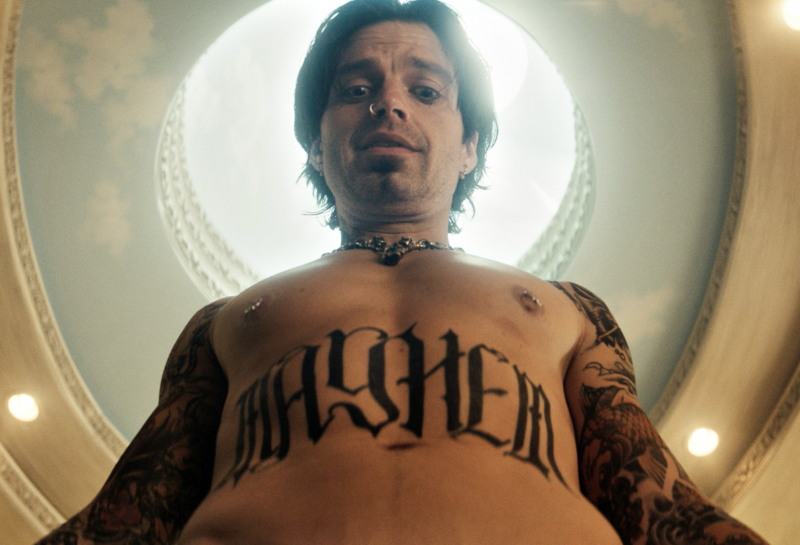There is a point midway through Episode 2 of the new Hulu series Pam & Tommy where Tommy Lee (played by Sebastian Stan) begins arguing with his own penis. The camera pans down to his crotch so the viewer can see close-up, an animatronic, flexing schlong with a talking tip. “We’ve gotta keep this pussy train rolling,” the peen (voiced by Jason Mantzoukas) demands. “Do you hear me?”
On-Screen Peen: Equal-Opportunity Nudity or Dangling Distraction?

This ridiculous display was the natural end point (pun intended) of months and months of TV shows trying to out-dick each other. As anyone with a regular streaming habit is no doubt aware, full-frontal male nudity is suddenly being embraced by the non-network channels like never before. HBO has, of course, been working to advance penile screen time since its earliest days. But in recent years, the channel has noticeably upgraded its wang locomotive from steam engine to bullet train. And it has inspired other channels to follow suit.
At the head of the HBO pack is Euphoria. The show has garnered praise for finally bringing equal opportunity nudity to the TV screen. But, boy oh boy, does it have a tendency to overdo it. You name a type of penis, it’s been on Euphoria. Old penis, erect penis, locker room penis, toilet penis, drug-dealer-house penis, about-to-get-shot penis, prosthetic penis, real penis. All of the penis, basically.
While HBO offers full-frontal male nudity in damn near everything (“Thanks for Steve Zahn’s fake balls in The White Lotus,” said nobody), nowhere has Euphoria’s influence been more obvious than in And Just Like That…, the Sex and the City reboot. This was a show that almost certainly would have benefited from more nudity in its original iteration, but remained a dong-free zone for the entirety of its six-season run in the 2000s. And yet its 2022 version managed to squeeze two ding-a-lings into a single episode. Neither acted as anything other than a dangling distraction in an otherwise sexless landscape.
All of which begs the question: How many on-screen penises are too many on-screen penises?
Twitter users have certainly reached a consensus with Euphoria. Sunday after Sunday, it’s clear that a broad swath of the audience thinks the show’s penile limit has been met and exceeded. (Not surprising when there were, infamously, “30 dicks” featured in the second episode of the first season.)
When TV centers and gratuitously lingers on male members, it can feel as jarring for the viewer as receiving unsolicited dick pics. And Euphoria knows how “terrifying” and “horrifying” dick pics can be. “There are two different types of dick pic,” Rue explained in season one. “Solicited and unsolicited. Solicited makes up about one percent of all dick pics sent and received.” At this point, a lot of women are simply sick to death of looking at penises they didn’t expressly ask to see. Actual studies have been done on this topic.
Last year, The Journal of Sex Research published a study that concluded:
In a U.S. sample of 2,045 women of all sexual identities and 298 gay/bisexual men, we found that among those who had ever received a ‘dick pic,’ nearly all (91%) had also received an unsolicited [one]. Women of all sexual identities predominantly experienced negative responses to these unsolicited nude images, with only a minority selecting any positive or neutral/ambivalent reactions.
The other risk of overdoing on-screen peen is the ammunition it gives to so-called men’s rights activists (and a whole mess of other humans) who use the objectification of men to further justify the objectification of women.

Then there are the campaigners who see this wave of TV penises and think, “Hey! How can we pressure women on our screens to get even more naked?”
There is of course a place for naked male bodies on television. It’s absurd that they’ve been such a rarity until fairly recently. It’s also still true that female actors are naked far more than their male counterparts. (We only need look at the nudity stats in Game of Thrones. There were only two full-frontal male scenes in its entire eight seasons. For women, the show reached that number in Episode 7 alone.) But there are thoughtful ways of showing audiences everyday nudity that doesn’t turn the whole thing into a gratuitous sideshow.
In Season 3 of Succession, for example, there is a scene in which Roman tries to send a dick pic to Gerri but accidentally sends it to his father Logan instead. The mortification Roman feels is enhanced by the fact that the viewer sees the intimate photograph too. We, along with Logan, are seeing something we shouldn’t. And its impact is heightened because it’s something we’ve never seen in Succession before. Had the series been a parade of unnecessary penises up to that point, it wouldn’t have been the scream-at-the-TV moment it was.
Even a show like Sex/Life, which doesn’t shy away from regular nudity, has figured out how to use it to advance the plot effectively. In the third episode, for example, Cooper follows his wife’s ex-boyfriend into the showers at the gym, only to be stunned by how generously endowed Brad is. The giant (prosthetic) penis featured in the episode wasn’t there for no reason: it was there as part of a storyline about insecurity in relationships. It was there as a traditional symbol of male virility. And it was there to highlight the physical pressures put on men over something they have no control over. Without seeing what Brad was working with, the viewer couldn’t fully comprehend Cooper’s inner turmoil.
The frustrating thing with Euphoria is that it almost gets it right all the time. In Season 2’s third episode, we see a flashback to Cal’s high school days. In it, we find out he was in love with his best friend and wrestling teammate, Derek. The moments of nudity they share in the locker room—even exchanging the same bar of soap in the shower—speak to a familiarity and an intimacy that would be hard to convey otherwise. It explains how they reach the point of feeling comfortable enough to dance together and make out in a gay bar despite being submerged in a world of toxic masculinity. Had the nudity been left at that, it would have been a powerful presence in their love story. Instead, we were also subjected to other, irrelevant penises in the shower, and lingering shots of floating underwater penis while Cal and Derek are skinny dipping. These moments undercut the power of their nude locker room bonding.
All of which is to say that full-frontal male nudity certainly has a valuable place on TV. Not just for the sake of realism in intimate scenes, but also in the service of specific, emotional plot points. But—like a flasher on a train—just because you can show penis, doesn’t necessarily mean you should show penis. In the rush to embrace equal opportunity nudity, some TV series have diminished their own value because of an inability to recognize that basic principle.

